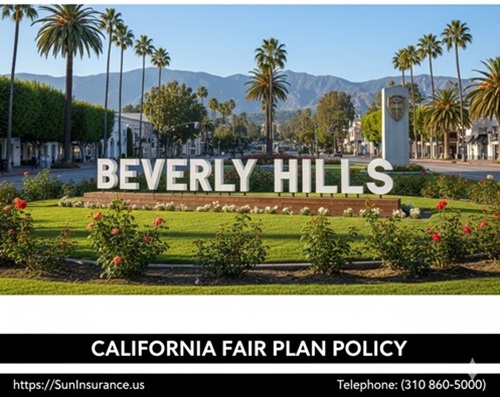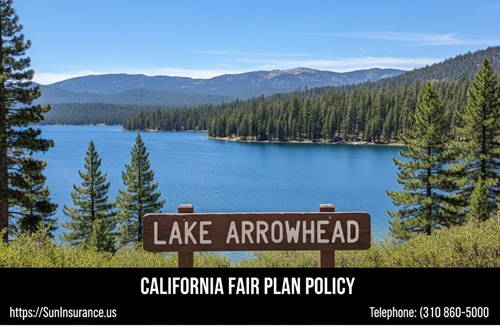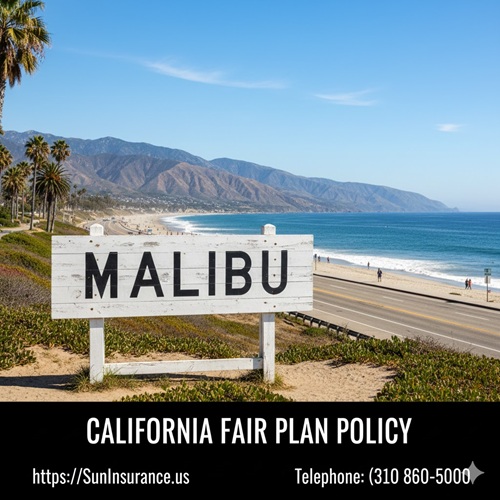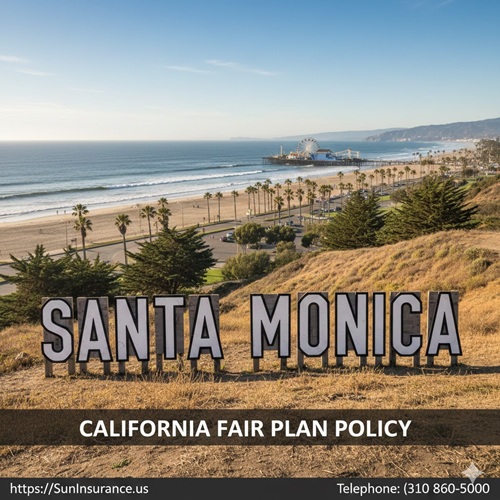
California Fair Plan policy has become the primary fire insurance solution for homeowners across cities such as Beverly Hills, Malibu, Pacific Palisades, Topanga Canyon, Big Bear Lake, Santa Monica, Palm Springs, Laguna Beach, and other wildfire-prone areas throughout California. As traditional insurance companies reduce or eliminate coverage in high-fire-risk zones, tens of thousands of homeowners are now forced to rely on the California Fair Plan policy as their main or sometimes only available option.
This expanded guide explains everything you need to know about the California Fair Plan policy, including coverage details, exclusions, who needs it, scenarios, pricing factors, comparison tables, examples of high-risk cities, and practical strategies to stay protected in 2025 and beyond.
If you want the best expert guidance in California, reach out to:
Sun Insurance & Financial
🌐 https://SunInsurance.us
📞 (310) 860-5000
Table of Contents 📘
- Understanding the California FAIR Plan Policy
- Why the California Fair Plan Policy Has Become Essential in 2025
- Who Is Eligible for a FAIR Plan Policy?
- What the FAIR Plan Covers
- What the FAIR Plan Does NOT Cover
- FAIR Plan vs. Standard Homeowners Insurance
- Why You Must Combine FAIR Plan + DIC Wrap
- The Rise of High-Risk Cities in California
- Detailed Real-Life Scenarios
- FAIR Plan Claims Process Step-by-Step
- FAIR Plan Premiums: How Cost Is Calculated
- How to Lower Your FAIR Plan Policy Premium
- Updated 2025 FAIR Plan Rules and Changes
- FAQ Section
- Strong Call to Action
1. Understanding the California Fair Plan Policy 🌄
The California FAIR Plan policy is a last-resort fire insurance option created to protect homeowners who can no longer obtain traditional home insurance. It is not a government handout; instead, it is supported by private insurance carriers who are required to participate in the state-mandated pool.
Due to wildfire extremes, insurers are declining renewals at record levels. Homes that once easily qualified for traditional insurance now receive non-renewal notices based solely on ZIP codes, Fireline scores, brush exposure, lot elevation, canyon proximity, and wildfire history.
This is why the California FAIR Plan policy has become a lifeline for homeowners throughout Los Angeles County, Ventura County, the San Bernardino Mountains, and even in parts of Northern California, such as Napa, Sonoma, and Santa Rosa.
2. Why the California Fair Plan Policy Has Become Essential in 2025 🔥

Severe Wildfire Activity
California’s wildfire seasons are longer and more destructive. Climate patterns, drought intensity, and fuel accumulation have increased the frequency of large-scale fires.
Insurance Company Withdrawals
Carriers such as State Farm, Allstate, Farmers, Chubb, Liberty Mutual, and The Hartford have all reduced or stopped offering new homeowner policies in high-risk areas.
Unpredictable Losses
Insurers claim that wildfire losses are now too unpredictable to price accurately. As a result, they cap exposure or withdraw entirely.
Rising Reconstruction Costs
Labor shortages, inflation in construction materials, supply constraints, and rising wages have driven the average rebuilding cost up by 20–40% since 2020.
Because of these factors, the California FAIR Plan policy is often the only available coverage—particularly in high-risk wildfire cities like Malibu, Topanga, Pacific Palisades, Calabasas, Brentwood Hills, Woodland Hills, and Big Bear Lake.
3. Who Is Eligible for a FAIR Plan Policy? 📝
The FAIR Plan is specifically designed for homeowners who have:
✔️ Been denied or non-renewed by traditional insurance
✔️ Homes located in wildfire-exposed areas
✔️ Homes with previous claims
✔️ Homes in brush-heavy zones
✔️ Vacation homes in remote areas
✔️ High-value homes where carriers pulled out
✔️ Landlord or rental units needing fire-only insurance
It is crucial to understand that the FAIR Plan does not judge applicants by:
- Credit score
- Income
- Employment
- Claims history (unless extreme)
As long as the structure is insurable, the homeowner can obtain a California FAIR Plan policy.
4. What the California FAIR Plan Policy Covers 🔥🏡
The FAIR Plan offers named-peril fire insurance, meaning it covers only specific risks. It does not function like a full homeowner’s policy unless paired with a DIC policy.
Core Coverage Includes:
🔥 Fire Damage
Coverage for partial or total destruction of a home.
🌫️ Smoke Damage
Smoke infiltration, soot, odor, and HVAC contamination.
⚡ Lightning Damage
💥 Internal Explosion
Including furnace explosions or ruptured gas pipes inside the home.
Optional Extended Coverage (EC)
Homeowners may add more protections:
- Windstorm
- Hail
- Riot
- Civil commotion
- Vehicle impact
- Aircraft damage
Optional Vandalism & Malicious Mischief
Great for:
- Vacation cabins
- Rental homes
- Remote properties
Dwelling Coverage
Up to $3 million per home.
Contents Coverage
Available but limited—typically less generous than standard policies.
Additional Living Expenses (Optional)
Provides temporary housing if the home becomes uninhabitable.
5. What the California Fair Plan Policy Does NOT Cover ⚠️

This is where many homeowners get misled.
FAIR Plan does NOT cover:
- Water damage
- Burst pipes
- Roof leaks
- Theft
- Liability
- Guest injuries
- Sudden & accidental damage
- Sewer backup
- Mold
- Falling objects
- Flood
- Earthquake
Because of these gaps, homeowners must purchase a DIC policy (Difference in Conditions) to restore complete protection.
6. California Fair Plan Policy vs. Standard Homeowners Insurance 🏘️
| Feature | California FAIR Plan | Standard Homeowners Policy |
|---|---|---|
| Fire | ✔️ | ✔️ |
| Smoke | ✔️ | ✔️ |
| Wind | Optional | ✔️ |
| Water Damage | ❌ | ✔️ |
| Theft | ❌ | ✔️ |
| Liability | ❌ | ✔️ |
| Burst Pipes | ❌ | ✔️ |
| Loss of Use | Optional | ✔️ |
| Earthquake | ❌ | Optional |
| Flood | ❌ | Optional |
In high-risk wildfire areas, traditional policies are often unavailable or unaffordable, leaving the California FAIR Plan as the only realistic option.
7. Why You Must Combine
California Fair Plan Policy
+ DIC Wrap 🔒

To create the equivalent of a standard homeowners policy, homeowners must combine:
The FAIR Plan (Fire + Smoke + Optional Wind)
The DIC Policy (Water, Theft, Liability, Burst Pipes, Etc.)
Together, they create full coverage.
Many homeowners mistakenly assume the FAIR Plan is enough—but without a DIC policy, your home is exposed to the most common losses (water, theft, liability).
If you want BOTH policies professionally designed and layered for maximum protection, contact:
Sun Insurance & Financial — (310) 860-5000
8. The Rise of High-Risk Cities in California and California Fair Plan Policy
📍🔥
Several California cities now rely heavily on the FAIR Plan due to wildfire exposure, brush density, or insurer withdrawal:
🌴 Beverly Hills – especially BHPO in the hills
🔥 Malibu – among the highest wildfire-risk ZIP codes
🌲 Big Bear Lake – cabin communities with older structures
🌊 Pacific Palisades – steep canyon roads and brush
🏞️ Topanga Canyon – extreme wildfire exposure
🏡 Calabasas – hillside neighborhoods
🚗 Laguna Beach – fire corridors near canyon winds
These regions experience some of the highest FAIR Plan applications year after year.
9. Detailed Real-Life Scenarios of
California Fair Plan Policy
🤯📘
Scenario 1: Malibu Wildfire (Total Loss)
A wind-driven wildfire sweeps through Malibu, destroying hundreds of homes.
The FAIR Plan pays:
- Full dwelling limit
- Debris removal
- Smoke damage cleanup
- Optional ALE (if purchased)
Scenario 2: Big Bear Cabin Vandalism
A seasonal rental home is vandalized in the off-season.
If VMM is added:
- Broken windows
- Damaged doors
- Graffiti removal
are covered.
Scenario 3: Pacific Palisades Smoke Infiltration
No flames reach the house, but thick smoke enters the property.
FAIR Plan covers:
- Full smoke remediation
- HVAC cleaning
- Odor removal
Scenario 4: Burst Pipe in Beverly Hills Home (Not Covered)
A pipe bursts while the homeowner is on vacation.
FAIR Plan does NOT pay.
The DIC policy does.
Scenario 5: Guest Injury (Not Covered by FAIR Plan)
A visitor slips on the stairs and sues.
FAIR Plan provides $0.
DIC liability coverage handles the lawsuit.
10. California Fair Plan Policy
Claims Process Step-by-Step 📑

Understanding the claims process helps homeowners recover faster:
Step 1: Report the Loss Immediately
Could you call the FAIR Plan or your agent?
Step 2: Mitigate Further Damage
You can protect the home from additional loss.
Step 3: Document the Damage
Take photos, videos, and written reports.
Step 4: Inspection
A FAIR Plan adjuster visits the site.
Step 5: Claim Evaluation
The adjuster estimates the cost of repairs.
Step 6: Payment Issued
Payments are made to you or your contractor.
Step 7: Rebuild
Use licensed contractors for all reconstruction.
Sun Insurance & Financial can guide you through every step — ensuring you don’t leave money on the table.
11. California Fair Plan Policy
Premiums: How Cost Is Calculated 💰
Several factors influence the price of a California FAIR Plan policy:
🔥 Fireline score
🌲 Brush proximity
🌄 Home elevation
🧱 Building materials
🏚️ Age of home
🧯 Fire mitigation efforts
👷 Construction labor costs
🏘️ Property location (e.g., Malibu vs. Santa Monica)
Homes in the hills or canyons typically pay more than homes near the coast.
12. How to Lower Your California Fair Plan Policy Premium 💰🔥

You can reduce premiums significantly by implementing:
✔️ Defensible space (100 feet)
✔️ Fire-resistant roofing (Class A)
✔️ Ember-resistant attic vents
✔️ Dual-pane windows
✔️ Metal fences instead of wood
✔️ Non-combustible hardscape
✔️ Automatic water shutoff devices
✔️ Home security system
✔️ Fire department access clearance
Sun Insurance can help you obtain FAIR Plan discounts.
13. Updated California Fair Plan Policy Rules and Changes 🆕
California has expanded FAIR Plan options in 2025:
🔹 Higher dwelling limits (up to $3M)
🔹 More availability for condos
🔹 Optional burglary & vandalism expansion
🔹 Increased ALE limits
🔹 Stronger mitigation credit programs
More updates are pending approval from the California Department of Insurance.
14. FAQ Section ❓💬
Q1: Does the FAIR Plan cover theft?
No. You need a DIC policy.
Q2: Does my mortgage accept the FAIR Plan?
Yes, if paired with a DIC wrap.
Q3: Does FAIR Plan cover wildfire?
Yes — wildfire is the primary covered peril.
Q4: How do I get full coverage?
Buy:
- FAIR Plan policy
- DIC wrap policy
Q5: Can the FAIR Plan cover luxury homes?
Yes — up to $3M in dwelling coverage.
15. Strong Call to Action ☎️🔥
For the most accurate, affordable, and customized California FAIR Plan policy:
Contact Sun Insurance & Financial
🌐 https://SunInsurance.us
📞 (310) 860-5000
Sun Insurance specializes in:
- California FAIR Plan
- DIC Wrap
- Wildfire zones
- Beverly Hills, Malibu, Pacific Palisades, Big Bear, Topanga
Get protected TODAY — before the next wildfire strikes. 🔥🏠🌴
Sun Insurance and Financial https://SunInsurance.us
Travelers Insurance
The Hartford Insurance
California Fair Plan Insurance
Hiscox Insurance
